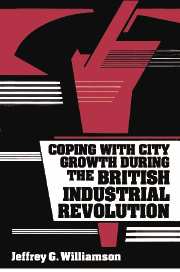Book contents
- Frontmatter
- Contents
- List of tables
- List of figures
- Acknowledgments
- 1 Coping with city growth, past and present
- 2 The urban demographic transition: Births, deaths, and immigration
- 3 Migrant selectivity, brain drain, and human capital transfers
- 4 The demand for labor and immigrant absorption off the farm
- 5 Absorbing the city immigrants
- 6 The impact of the Irish on British labor markets
- 7 Did British labor markets fail during the industrial revolution?
- 8 Did Britain's cities grow too fast?
- 9 City housing, density, disamenities, and death
- 10 Did Britain underinvest in its cities?
- References
- Index
2 - The urban demographic transition: Births, deaths, and immigration
Published online by Cambridge University Press: 03 May 2010
- Frontmatter
- Contents
- List of tables
- List of figures
- Acknowledgments
- 1 Coping with city growth, past and present
- 2 The urban demographic transition: Births, deaths, and immigration
- 3 Migrant selectivity, brain drain, and human capital transfers
- 4 The demand for labor and immigrant absorption off the farm
- 5 Absorbing the city immigrants
- 6 The impact of the Irish on British labor markets
- 7 Did British labor markets fail during the industrial revolution?
- 8 Did Britain's cities grow too fast?
- 9 City housing, density, disamenities, and death
- 10 Did Britain underinvest in its cities?
- References
- Index
Summary
Why do we care about the urban demographic transition?
A reconstruction of the demographic dimensions of the urban transition should help improve our understanding of the First Industrial Revolution.
Certainly it is essential in searching for answers to any of the following questions: Did English cities grow more by natural increase than by migration? Did city immigration rates rise as industrialization accelerated? Did rural emigration rates respond vigorously to the employment demands of rapid city growth, or were rural Englishmen more attached to the land than has been true of other industrial revolutions? Was migration selective? If so, what was the impact of the selectivity on the city economy? What role did push and pull forces play in rural and urban labor markets? These questions have always been at center stage in debates about the First Industrial Revolution. The answers will hinge on an assessment of those forces creating and displacing jobs in the two labor markets, as well as on the migration behavior thought to link them, assessments which cannot be made without the prior demographic reconstruction performed in this chapter.
Consider, for example, the Third World overurbanization debate which was initiated by Bert Hoselitz in the 1950s. His thesis was that urbanization was outpacing industrialization in the sense that urban populations were large relative to industrial jobs, at least when compared with late nineteenth-century experience (Hoselitz 1955, 1957). The implication was that urban labor was moving into low-wage, residual service underemployment by default.
- Type
- Chapter
- Information
- Publisher: Cambridge University PressPrint publication year: 1990



